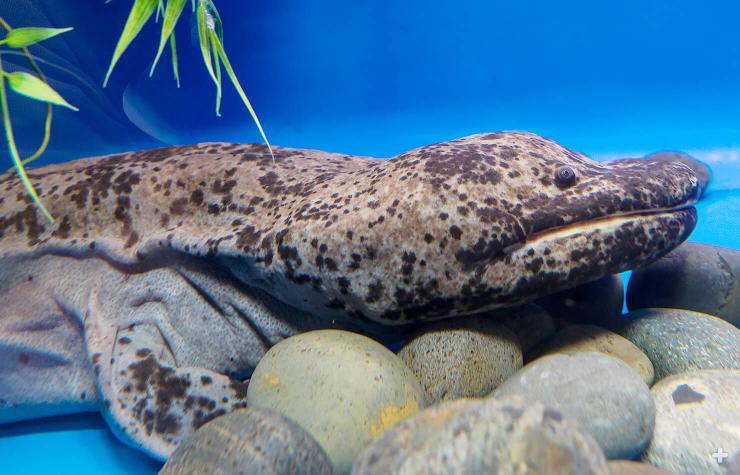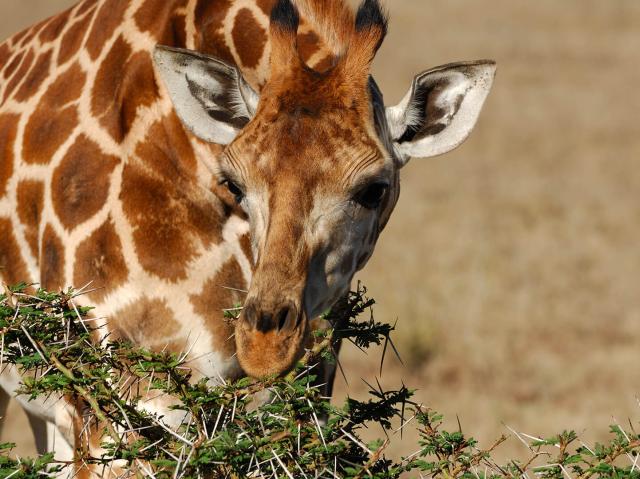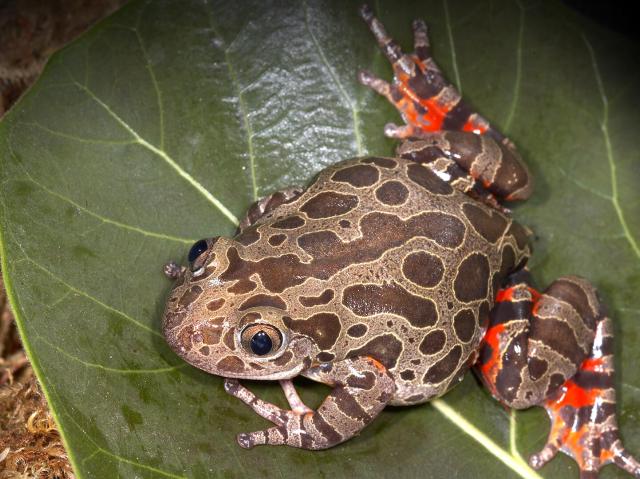
Chinese Giant Salamander

- Class: Amphibia
- Order: Urodela
- Family: Cryptobranchidae
- Genus: Andrias
- Species: davidianus

ABOUT
Capable of growing nearly 6 feet in length (1.8 meters) and living as long as your grandparents, the mighty Chinese giant salamander once had the world at its wet, stubby feet. It’s a “living fossil,” having seen the dinosaurs come and go, and it is currently the largest amphibian on the planet.
Chinese giant salamanders are one of three known “giant” types, all of which diverged from other amphibians during the Jurassic Period (about 170 million years ago). The Japanese giant salamander is a bit smaller than its Chinese counterpart, while North America’s largest salamander, the hellbender, may reach 28 inches (70 centimeters) in length. These three giants make up the family Cryptobranchidae.
Sleek and mysterious, this creature lives underwater yet does not have gills—it absorbs oxygen through its skin! The Chinese giant salamander is a flagship species for China’s freshwater river ecosystems. Despite its “giant” status, this salamander is now critically endangered due to over-harvesting for human consumption, as well as habitat loss and water pollution.
Revered for thousands of years, and later feared and avoided—which wasn’t too difficult, given their penchant for fast-running mountain streams—its luck ran out in the 1970s when a market grew for “exotic” giant salamander meat, accompanied by an uptick for use in traditional remedies. This led to thousands of Chinese giant salamander farms cropping up around the country—and some salamanders sell for more than $1,500 each!
In a study published in the journal Current Biology, scientists traced the genetics of 1,100 giant salamanders and discovered that they were more evolutionarily distinct than previously thought. The results suggest that there could be at least five distinct giant salamanders that developed independently in isolated locations over millions of years.
So, while it may seem that that populations bred in human care may save the salamander, the opposite is true. These salamanders are still poached from rivers with impunity to stock farms, and China’s Ministry of Agriculture supports the reintroduction of farmed salamanders back into waterways. Though the reintroductions are well-intentioned, these individuals are often fully hybridized at the farms and may carry diseases such as ranavirus, spelling disaster for authentic genetic lineages within the five possible species.
Deep dive. An international team of scientists conducted an intense, four-year survey that covered 97 sites across 16 Chinese provinces of prime freshwater amphibian habitat in China. Observing salamanders was exceedingly rare, and interviewing local people revealed that in many areas, salamanders had not been seen for nearly 20 years.
Nothing to see here. Chinese giant salamanders are expertly camouflaged against the rocky river bottoms. It is a mottled grayish or greenish and brown, with a long, thick body with four stubby limbs, and a blunt head with tiny eyes (with no eye lids) behind its nostrils. Its tail makes up over half of its body length. As if to lighten up its daunting appearance, its mouth is often bent into a slight, smug grin.
The salamanders’ large size and lack of gills likely confine them to fast-flowing rivers, where oxygen is plentiful. A conspicuous fold of skin along the salamanders’ flanks increases the surface area of skin through which oxygen can be taken in.
Hook, line, and sinker. Juvenile giant salamanders may be fair game for predators, including larger salamanders. But the main threat to Chinese giant salamanders is humans hunting them with nets and hooks. As apex predators, they are used to slurping up a wide variety of aquatic creatures, and can accidentally swallow or become tangled in lines of hooks.
Unfortunately, the Chinese giant salamander has become a fashionable delicacy among the wealthy and is heavily poached, despite laws to protect them. Their habitat has become fragmented and their numbers have plummeted by 80 percent over the last few decades.
HABITAT AND DIET
Rushing home. The Chinese giant salamander is endemic to rocky, mountain rivers and large streams in China. They spend their time filling the top predator niche in rushing, freshwater ecosystems, chowing down on fish, frogs, worms, snails, insects, crayfish, crabs, and even smaller salamanders. They feed using an efficient suction technique.
Good vibrations. These amphibians spend their entire lives underwater, yet they do not have gills—they absorb oxygen through their porous skin. Their tiny eyes aren’t much help, and instead they detect prey by sensing their vibrations in the water. Sensory nodes run along the sides of the Chinese giant salamander's body from head to tail, enabling it to detect prey. They are more active at night, on the prowl for food, and they hole up in underwater hollows and cavities during the day.
Males may defend an underwater den where females can lay their strings of eggs, and he will fertilize them and protect the area until they hatch.
FAMILY LIFE
String him along. The breeding season is July, August, and September when the water temperature is 68 degrees Fahrenheit (20 degrees Celsius), and they travel upstream. Females lay 400 to 500 eggs in a "string," in an underwater burrow or cavity defended by a “den master,” who fertilizes them externally with a blast of milky sperm. He protects and cares for the eggs until they hatch, one to two months later. Larvae develop in the streams, taking food after about a month. There is no parental care.
The youngsters reach maturity at 5 or 6 years of age, and can reach 16 to 20 inches (40 to 50 centimeters) in length.
Don’t cry. The Chinese giant salamander produces sounds that resemble a baby’s cry, earning it the ironic (and inaccurate) nickname “baby fish.”
CONSERVATION
Save the giant salamanders! It's clear that this Critically Endangered salamander needs all the help it can get. While laws and policies may help its plight, consumers also play a crucial role in the its conservation. Don't fuel the demand for them by consuming their meat or using their body parts as a remedy. With a little help, this ancient salamander can rebound and thrive again beneath the rushing waters of China's mountain river systems.
By supporting San Diego Zoo Wildlife Alliance, you are our ally in saving and protecting wildlife worldwide.











